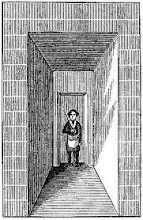According to Filipino historian Reynold Fajardo, in his book “Dimasalang: The Masonic Life of Dr. Jose Rizal,” Rizal was not only a mason, he was the only one among the leaders of the revolutionary movement during the Spanish era who “deserved to be called an international Mason since he was a member of various Masonic lodges in Spain, Germany, France and possibly, England.”
Dr. Jose Rizal, an international Mason
According to Filipino historian Reynold Fajardo, in his book “Dimasalang: The Masonic Life of Dr. Jose Rizal,” Rizal was not only a mason, he was the only one among the leaders of the revolutionary movement during the Spanish era who “deserved to be called an international Mason since he was a member of various Masonic lodges in Spain, Germany, France and possibly, England.”
The Philippine Flag - Its Masonic roots.
 Time and again it has been asserted that masonry played an important role in the design of the Philippine flag and that some of its symbols were meant to memorialize the Craft. These assertions are essentially plausible, for the man principally responsible for its design — President Emilio Aguinaldo — was a zealous masonic partisan. In one of his speeches delivered after the Revolution, Aguinaldo said; "The successful Revolution of 1896 was masonically inspired, masonically led, and masonically executed. And I venture to say that the first Philippine Republic of which I was its humble president, was an achievement we owe, largely, to masonry and the freemasons."
Time and again it has been asserted that masonry played an important role in the design of the Philippine flag and that some of its symbols were meant to memorialize the Craft. These assertions are essentially plausible, for the man principally responsible for its design — President Emilio Aguinaldo — was a zealous masonic partisan. In one of his speeches delivered after the Revolution, Aguinaldo said; "The successful Revolution of 1896 was masonically inspired, masonically led, and masonically executed. And I venture to say that the first Philippine Republic of which I was its humble president, was an achievement we owe, largely, to masonry and the freemasons."
Words to ponder by: On Freemasonry
Sharing some texts from excerpts of “MASONRY AND THE PHILLIPINE REVOLUTION” by MWBro Reynold S Fajardo and likewise a reminder of our continuing commitment as Masons to ……”BROTHERLY LOVE, RELIEF, TRUTH and LIBERTY, EQUALITY, FRATERNITY”.
A nice lesson of masonry worth sharing
The Story Behind Forget Me Not Emblem!
 In the years between World War 1 and World War 2 The blue Forget Me Not Emblem (Das Vergissmeinnicht) was a standard symbol used by most charitable organizations in Germany, with a very clear meaning: “Do not forget the poor and the destitute“. It was first introduced in German Masonry in 1926, well before the Nazi era, at the annual Communication of the Grand Lodge Zur Sonne, in Bremen, where it was distributed to all the participants. That was a terrible time in Germany, economically speaking, further aggravated in 1929 following that year’s Great Depression.
In the years between World War 1 and World War 2 The blue Forget Me Not Emblem (Das Vergissmeinnicht) was a standard symbol used by most charitable organizations in Germany, with a very clear meaning: “Do not forget the poor and the destitute“. It was first introduced in German Masonry in 1926, well before the Nazi era, at the annual Communication of the Grand Lodge Zur Sonne, in Bremen, where it was distributed to all the participants. That was a terrible time in Germany, economically speaking, further aggravated in 1929 following that year’s Great Depression. Annual Family Christmas Party
Typhoon Ondoy Relief Operation
"The Masonic Ring"
Those men who help my dad each day,
They wear those Mason rings.
A Square and Compass set in gold,
The praise of which I sing
Medical Mission
CBCP pastoral letter on freemasonry
Brief History of Freemasonry in the Philippines
 In the Beginning… The history of Philippine Masonry may be likened to the history of the first Grand Lodge. On the Feast of St. John the Baptist in 1717, four of the pre-existing Masonic lodges in Great Britain organized what became the first Grand Lodge of the world. On December 19, 1912, three lodges that were chartered under the Constitution of the Grand Lodge of California finally succeeded in establishing the Grand Lodge of Free and Accepted Masons of the Philippine Islands, the forerunner of what is now officially known as the Most Worshipful Grand Lodge of Free and Accepted Masons of the Philippines. Masonry existed in England long before the creation of the first Grand Lodge, so was Philippine Masonry already alive even before the formation of the Grand Lodge of the Philippine Islands.
In the Beginning… The history of Philippine Masonry may be likened to the history of the first Grand Lodge. On the Feast of St. John the Baptist in 1717, four of the pre-existing Masonic lodges in Great Britain organized what became the first Grand Lodge of the world. On December 19, 1912, three lodges that were chartered under the Constitution of the Grand Lodge of California finally succeeded in establishing the Grand Lodge of Free and Accepted Masons of the Philippine Islands, the forerunner of what is now officially known as the Most Worshipful Grand Lodge of Free and Accepted Masons of the Philippines. Masonry existed in England long before the creation of the first Grand Lodge, so was Philippine Masonry already alive even before the formation of the Grand Lodge of the Philippine Islands.








